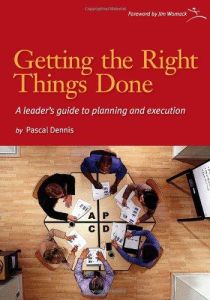Join getAbstract to access the summary!

Join getAbstract to access the summary!
Pascal Dennis
Getting the Right Things Done
A Leader’s Guide to Planning and Execution
Lean Enterprise Institute, 2006
What's inside?
Pascal Dennis explains how to use Toyota’s hoshin kanri system to implement and sustain a Lean strategy.
Recommendation
Efforts to adopt Lean principles often fall short because managers focus too much on choosing a strategy and not enough on executing it. Pascal Dennis offers a program for strategy deployment, drawn from Toyota’s hoshin kanri system, that outlines the steps for designing, implementing, monitoring and adjusting a strategy. The plan is straightforward, although the reader must navigate a thicket of four-part, six-step and seven-stage tools and absorb such concepts as the action tree, the A3 storyboard and the ladder of abstraction. Fortunately, Dennis presents all this through the easy-to-follow story of a successful strategy deployment at the fictitious Atlas Industries.
Summary
About the Author
Faculty member of the Lean Enterprise Institute Pascal Dennis is an engineer, author, consultant and winner of the ASQ Golden Quill, a 2006 Shingo Prize and the OSH Award of Excellence.

















Comment on this summary